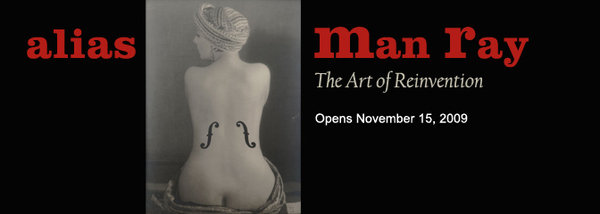Alias Man Ray
dal 14/11/2009 al 13/3/2010
Segnalato da
14/11/2009
Alias Man Ray
The Jewish Museum, New York
The Art of Reinvention. A major exhibition considering how the artist's life and career were shaped by his turn-of-the-century American Jewish immigrant experience and his lifelong evasion of his past. The show explores the deliberate cultural ambiguity of Man Ray who became the first American artist to be accepted by the avant-garde in Paris. It also examines the dynamic connection between Man Ray's assimilation, the evolution of his art, and his willful construction of a distinctive artistic persona, as evidenced in a series of subtle, encrypted self-references throughout his career.

A trailblazing figure in 20th-century art, Man Ray (1890-1976) revealed multiple artistic identities over the course of his career – Dadaist, Parisian Surrealist, international portrait and fashion photographer – and produced many important and enduring works as a photographer, painter, filmmaker, writer, sculptor, and object maker. Relatively few people know that he was born Emmanuel Radnitzky to Russian Jewish immigrants. In fact, he spent a lifetime suppressing his background to the point of denying he was ever called anything but Man Ray.
The Jewish Museum will present Alias Man Ray: The Art of Reinvention from November 15, 2009 through March 14, 2010, a major exhibition considering how the artist’s life and career were shaped by his turn-of-the-century American Jewish immigrant experience and his lifelong evasion of his past. The exhibition explores the deliberate cultural ambiguity of Man Ray who became the first American artist to be accepted by the avant-garde in Paris. It also examines the dynamic connection between Man Ray’s assimilation, the evolution of his art, and his willful construction of a distinctive artistic persona, as evidenced in a series of subtle, encrypted self-references throughout his career.
Visitors to Alias Man Ray will be privy to the artist’s endless experimentation in over 200 works including photographs, paintings, sculptures and objects, drawings, films and a selection of his writings. As the first major multimedia Man Ray show at a New York City museum since 1974, the exhibition will present many iconic works like the photographs Le Violon d’Ingres (1924) and Noire et Blanche (1926); the paintings War (A.D. MCMXIV) (1914), The Rope Dancer Accompanies Herself with Her Shadows (1916) and La Fortune (1938); and the wood screen La Fôret Dorée de Man Ray (1950).
Best known as a photographer, Man Ray in fact moved from one medium to another as he defied aesthetic boundaries. The Jewish Museum show does not confine itself to one period of the artist’s career or a single medium, such as photography. This approach is essential to illustrating how Man Ray continuously broke with aesthetic tradition and forged a new artistic identity.
He came of age at the beginning of the 20th century and the rise of abstract art. Man Ray grew up in Williamsburg, Brooklyn. His father worked as a tailor and his mother was a seamstress. After being introduced to New York art circles by photographer and gallery owner Alfred Stieglitz, he went off to Paris—the center of experimental art—and was embraced by the avant-garde. The year was 1921 and Man Ray was 31. In Paris, he was perceived as neither Jewish nor a New Yorker but as a free-thinking American who quickly gained notice.
To make ends meet, he took assignments photographing a broad spectrum of literary and artistic figures. That group now reads like a modernist pantheon—André Breton, Jean Cocteau, Marcel Duchamp, James Joyce, Ernest Hemingway, Marcel Proust and Gertrude Stein, among others. These innovative portraits, all on view in the exhibition, provide a chronicle of the social milieu in which Man Ray thrived.
Man Ray engaged in a constant process of self-inscription and erasure, managing to outwit anyone who wanted to label him. Like his fellow Dadaist and close friend Marcel Duchamp, Man Ray took delight in playing games and confounding expectations. With his steadfast independence and his need to explore every artistic avenue, Man Ray forged a vision that changed the very way art was conceived.
The exhibition has been organized by Mason Klein, Curator at The Jewish Museum. The accompanying 256-page catalogue with 246 illustrations, co-published by Yale University Press and The Jewish Museum, includes essays by Mr. Klein, Merry Foresta, and George Baker, with an illustrated timeline by Lauren Schell Dickens presenting the facts of Man Ray’s life in the cultural and historical context of his times. The hardcover book is available at The Jewish Museum’s Cooper Shop and bookstores everywhere for $50.00.
Alias Man Ray: The Art of Reinvention is supported by generous grants from S. Donald Sussman and the David Berg Foundation. Major funding was also provided by the Peter Jay Sharp Foundation, the National Endowment for the Arts, the Anna-Maria and Stephen Kellen Foundation, the Leon Levy Foundation, and Ellen S. Flamm. Additional support was provided by the Neubauer Family Foundation Exhibition Fund and other donors.
The exhibition is sponsored by the Jerome L. Greene Foundation.
The catalogue is funded through the Dorot Foundation publications endowment.
Press contacts:
Anne Scher or Alex Wittenberg 212.423.3271 or pressoffice@thejm.org
Opening Sunday, November 15th
The Jewish Museum
1109 Fifth Avenue at 92nd Street, New York
Museum hours are Saturday, Sunday, Monday, Tuesday and Thursday, 11am to 5:45pm; and Friday, 11am to 4pm
Museum admission is $12.00 for adults, $10.00 for senior citizens, $7.50 for students
free for children under 12 and Jewish Museum members
Admission is free on Saturdays



